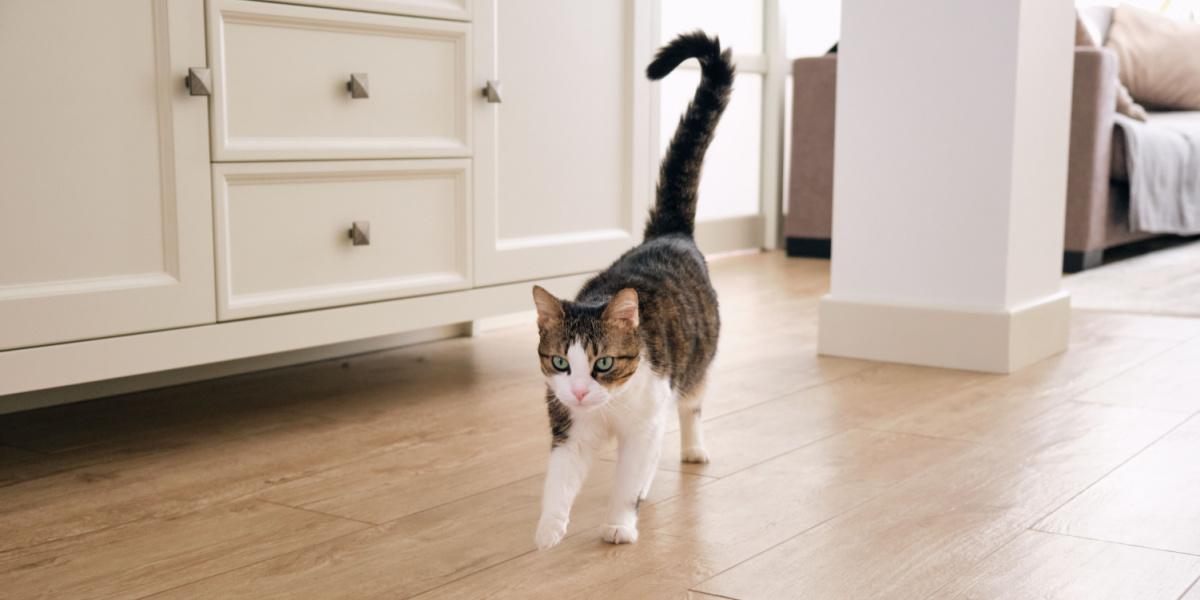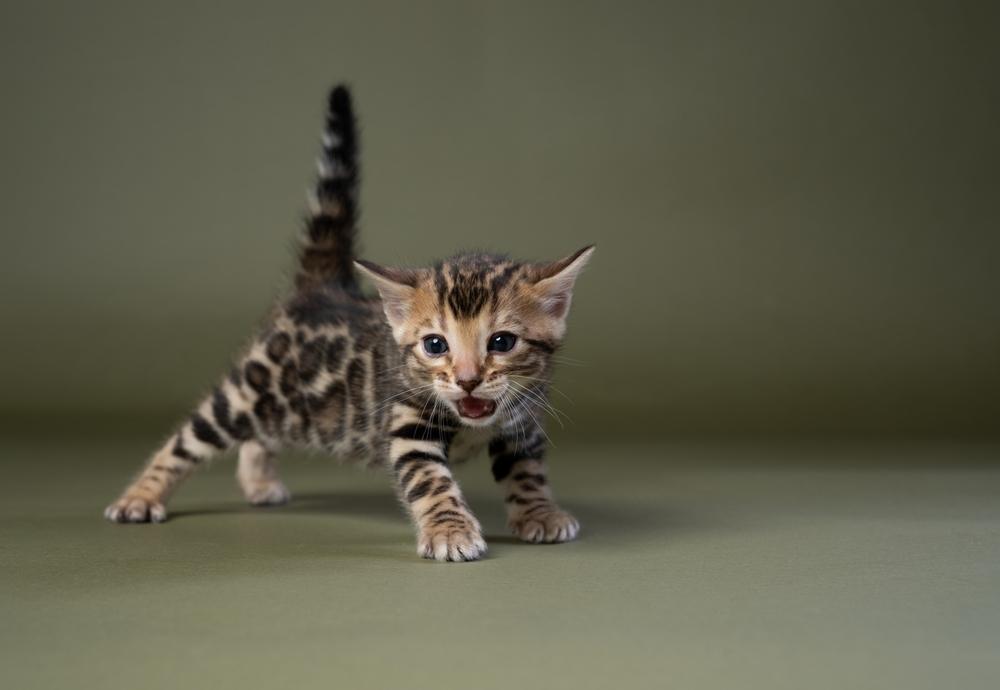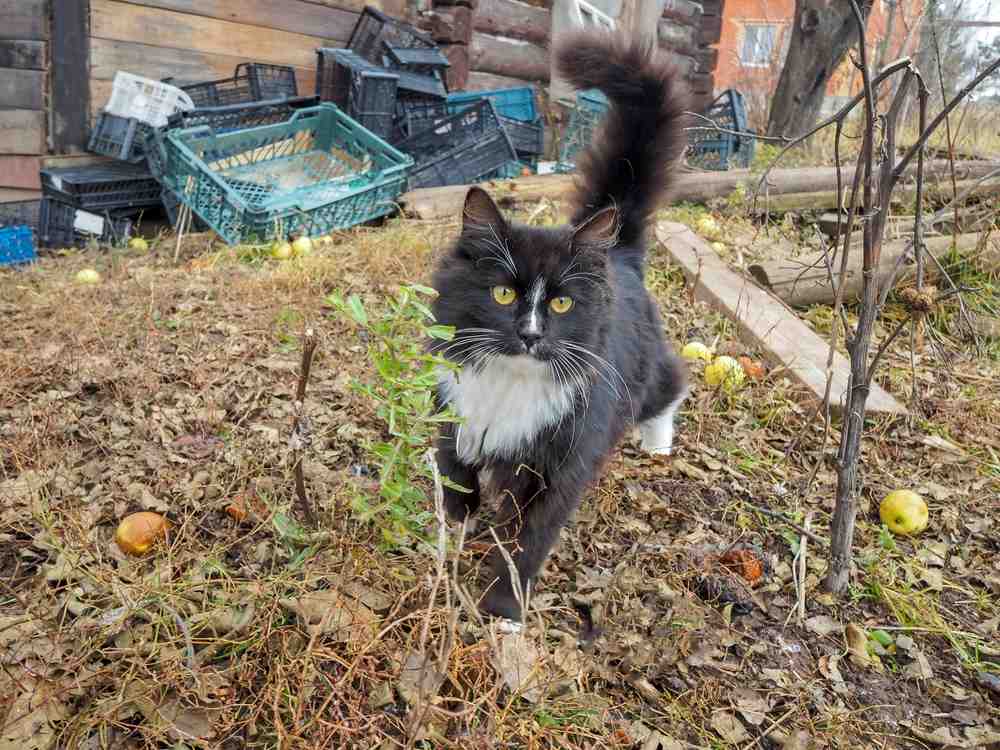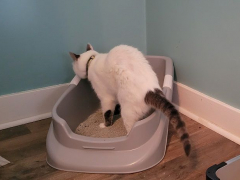
Most of our readers will likely have seen a cartoon cat with a puffed-up tail at some point, and if you’re a cat owner or lived near a cat you might have seen it happen in real life too. In the cartoons, cats might be depicted with a puffed-up tail for comedy value, but what does this behavior really mean? Should you be worried about it?
Cats can puff up their tails with the same piloerection mechanism that causes our hair to stand on end.
Cats usually puff up their tails in response to being startled or feeling threatened, because it makes them look bigger and feel braver.
Sometimes cats, especially young ones, puff up their tails during playtime - especially if their hunting, stalking, or wrestling is realistic!Key Takeaways
Thankfully, a puffed-up tail is a very normal behavior in cats and is just another way that they show their emotions. It happens in response to certain situations or stimuli, such as when they feel threatened or fearful. Let’s take a look at how a cat puffs up their tail and what might cause it.
What Makes a Cat’s Tail Puff Up?
Your cat’s tail is covered with fur, just like human skin is covered with tiny hairs. The mechanism by which a cat’s tail puffs up is known as piloerection and is similar to when our hair stands on end when we have goosebumps because we’re cold or a little creeped out.
Each hair is attached to a muscle known as a piloerector muscle. In response to certain stimuli, the muscle pulls on the hair shaft causing it to stand up rather than lying flat alongside the skin. For us humans, this creates an insulating layer of warm air trapped between the hairs, but cats have other uses for this phenomenon!
Why Do Cats Puff up Their Tails?
In general, cats puff their tails up to make themselves look bigger and more intimidating. If you’ve ever seen a cat with a puffy tail, you’ll know they can reach double or even triple their original volume! This doesn’t just scare off any potential threats, but it might also make them feel a little bit braver too!
It’s feline instinct to use a puffed-up tail in combination with other cat body language signals to warn off other cats, larger wildlife, dogs, or even people. So, alongside a puffy tail, you might notice the hair standing on end on your cat’s back. They might also have dilated pupils and may hiss, growl, yowl, arch their back, hold their ears back and flat to their head, and squint or frown.
What Does It Mean When a Cat Puffs up Their Tail?

Cats often puff up their tails to make themselves look bigger and scarier in the face of a threatening situation.
Here are some of the most common reasons why you might expect your cat to puff their tail:
1. Your Cat Feels Threatened
A threat of any description could cause your cat to puff up their tail. It might be a sudden movement, a loud noise like a firework or shaken plastic bag, or the unexpected presence of an unfamiliar cat or dog.
A puffed-up tail happens mostly as a response to being startled, rather than a gradually developing danger, but if your cat is squaring up to an opponent, they might puff up their tail as they get closer. It might seem like an odd thing to do, but from your cat’s point of view, they’re making themselves seem as large and scary as possible to try to make any potential attacker think twice!
2. They’re Angry
It’s not just fear that could make a cat puff up their tail, it can also be used as a sign of aggression, especially if they are involved in a confrontation with another cat while defending their territory. While cats most often swish their tail when they’re angry, if they’re feeling particularly vulnerable they might also puff their tail.
This gives everyone, be that cat or human, a clear signal to stop doing what they’re doing and give them some space. There are some other clear signals of anger your cat might display in this case.
3. Your Cat Is Scared
Anything that causes your cat to feel afraid, shocked or anxious could cause them to puff their tail, even if it turns out to be something completely innocent, like a door slamming or a stampede of young children playing in the house. Puffing their tail is your cat’s natural response to try to keep themselves safe, just in case. In addition, you might notice other signs of your cat’s fight or flight response.
If your cat often seems scared and shy, our article 8 Ways to Help a Scared and Fearful Cat be Confident could help.
4. They’re Fighting or Ready To Attack
If your cat is engaged in a one-on-one with another cat from the neighborhood, especially if they’re backed into a corner or feel like they don’t have the upper hand (or paw!), they’re likely to puff up their tail. This will help make them feel braver, as well as give the impression that they’re stronger and more confident than they actually are.
5. Your Cat May Be Playing
Yes, you did read that right – cats don’t just puff up their tails when they’re mad or scared, sometimes they puff up their tails because they’re having fun. This happens most often when young cats or kittens engage in play that simulates hunting, pouncing, or fighting, either with other cats or a toy. Although it’s not ‘for real’, your cat’s tail might still puff up in response to it! While this behavior is less common in adult cats, if your cat is particularly playful you might still notice it.
What Should You Do if Your Cat’s Tail Is Puffed Up?

Cats with a puffed tail may need some space to calm down, or reassurance if they are frightened.
A puffed up tail usually indicates that your cat is experiencing something negative, whether that’s fear, anger or threat. They may need a little time and space to calm down – perhaps in a comfy bed or raised shelf. If your cat has had a fright, they may seek out reassurance from you, so provide some gentle petting if they want it, and a soothing tone of voice.
It’s usually nothing to worry about if your cat’s tail puffs up – it shouldn’t last long and once the situation is over or the stimulus has disappeared their tail should be back to normal. However, as a pet parent, you’ll get to know your cat’s normal behavior and you’ll know when things don’t seem quite right.
If you start noticing your cat with a puffed-up tail regularly, where you hadn’t noticed it before, it could mean that they’re finding something in their environment stressful or scary. If they are an outdoor cat, it could mean that there’s a new cat in town, whereas if they spend all or most of their time indoors it could be due to noisy building work or boisterous children.
If you are concerned about your cat and think that something isn’t quite right, it’s always a good idea to speak to your veterinarian.
Related Conditions:
- 5 Visual Signs Of A Stressed Cat And How To Help
- Feline Idiopathic Cystitis: Causes, Symptoms, & Treatment
- Repetitive, Excessive And Compulsive Grooming In Cats
- Abscesses In Cats: Causes, Symptoms, And Treatment
Frequently Asked Questions
What does it mean when a cat's tail puffs up?
A cat puffing their tail up usually means that they feel threatened by something. This could be a major incident like being chased by a dog, but it's equally likely to be an innocent loud noise like a sudden door slam. A puffed-up tail is common in fearful cats, but it should return to normal size very quickly.
Do cats flap their tails when happy?
When a cat swishes or flaps their tail it usually means they're feeling quite cross. Take a look at their body language – are their ears back? Is their brow furrowed? Is their back arched? If so, it's time to give them some space.
Why do cats' tails go up when they're happy?
Cats often raise their tails when they are happy. Sometimes they do this when they are being petted to ensure the transfer of their scent from the scent glands at the base of their tail onto your hand. Equally, though, a raised tail is a sign that they are feeling confident and safe in your presence – way to go!








I believe that a POOFED tail simply means “very”. Very excited-a fresh bag of Catnip, perhaps a favorite toy or very glad to see me.
Very scared-this would be the stereotyped Halloween cat with it’s back arched & it’s ears turned backwards & flat to its skull.
Very angry-the body language is similar to “very scared” but is accompanied by aggressive growling, snarling & showing teeth.
Very playful-I had a 3y/o who did this nightly. He was poofed all over when he’d run into the kitchen. He’d turn sideways & start bouncing towards me a few times. Then he’d scamper out of the kitchen, but run right back immediately. After a while, I started raising my arms & taking a step towards him. He’d scamper away & run right back into the kitchen to repeat his playful routine.
If you want to know what your cat is “saying” you need to look at their entire body & any vocalizations. Many cats are similar, but no two are exactly the same.